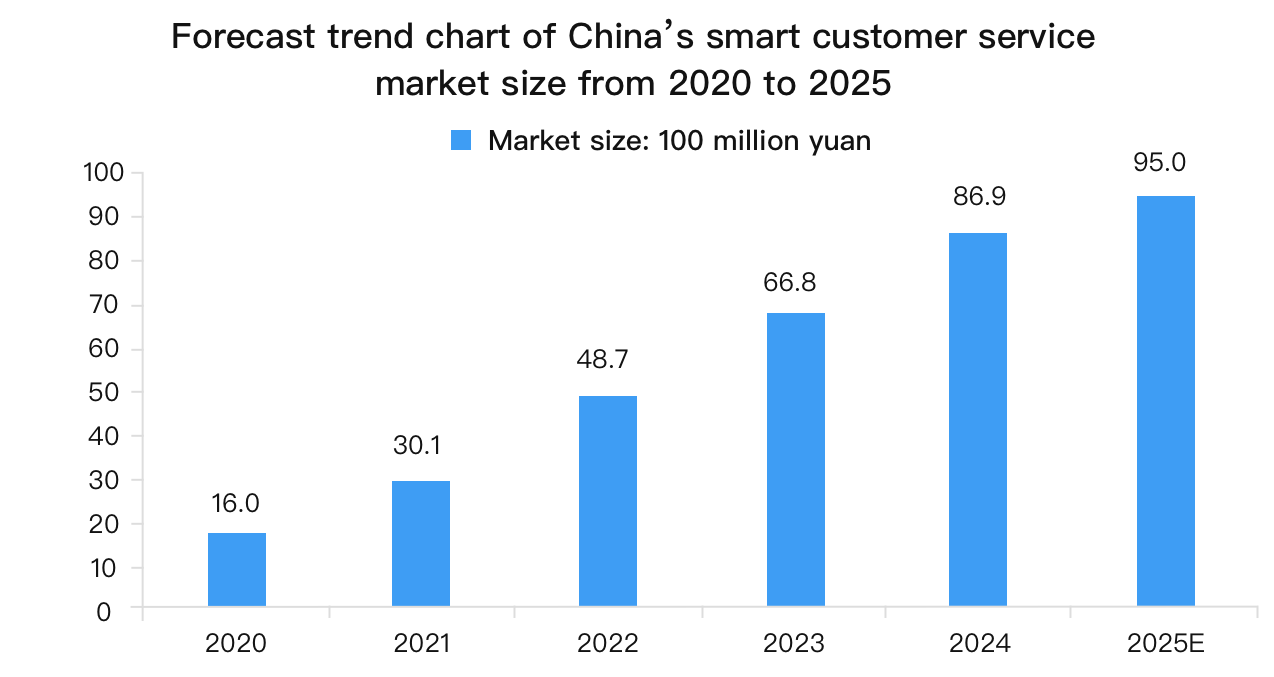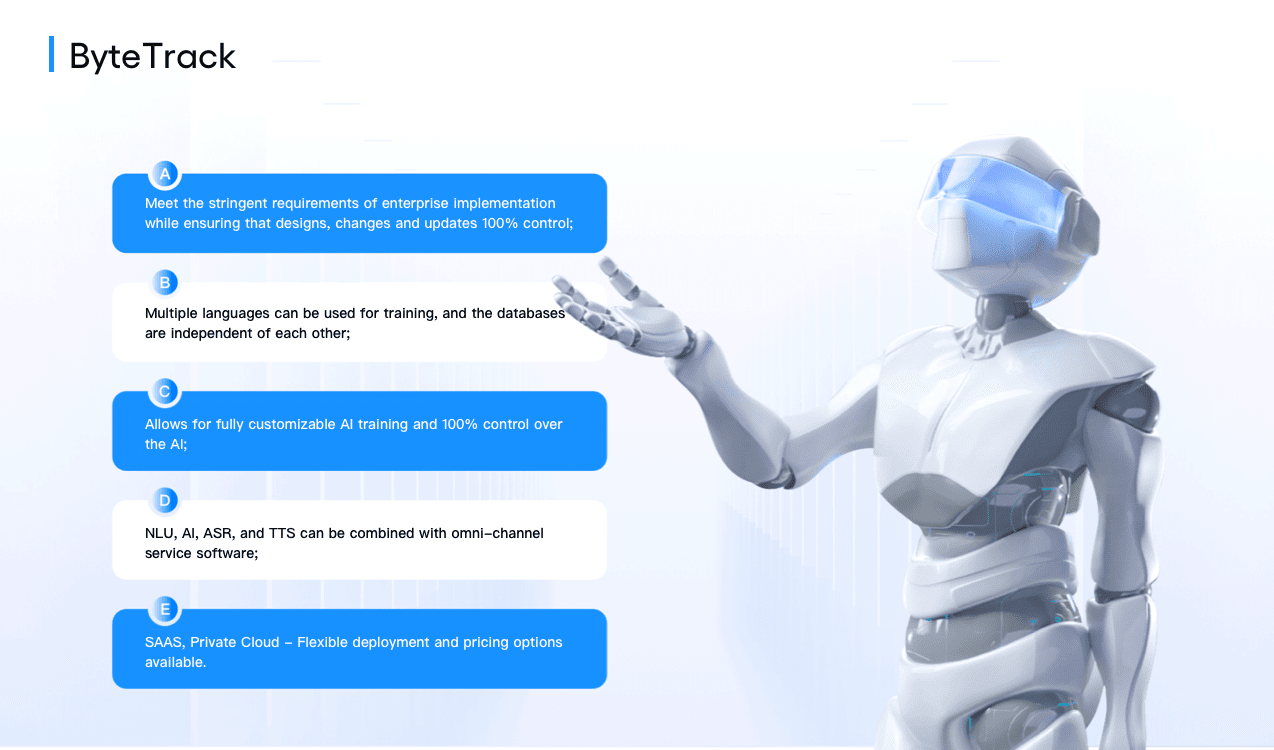How Businesses Can Choose the Best Customer Service System
How can you pick the most suitable intelligent customer service system for your business from the many available? Bytetrack carefully selects for you.
1. Why Choose a Customer Service System

According to relevant data, the demand for customer service systems in the Chinese market is increasing. Traditional manual customer service can no longer meet the diverse needs of customers. Only AI-powered intelligent customer service systems can easily handle these challenges. Nowadays, companies have two paths to implement intelligent customer service systems:
1. Self-design: Stable business development allows companies to design a customer service system that suits their unique characteristics. However, this method requires significant time and money, and the final result is not guaranteed.
2. Choose a third-party system: Select a third-party customer service system based on business needs.
In the modern business environment, customer service systems have become important tools for improving customer satisfaction, increasing operational efficiency, and enhancing market competitiveness. Choosing a suitable customer service system can help companies achieve the following goals:
1. Improve customer satisfaction: Respond quickly to customer issues, provide personalized service, and increase customer loyalty.
2. Enhance work efficiency: Centralize customer inquiries, automate common issues, and reduce labor costs.
3. Data-driven decisions: Collect and analyze customer data to gain insights and help optimize services and products.
2. Determine Needs Based on Business
After deciding to use a third-party customer service system to improve service quality, companies need to focus on the following two issues:

1. Usage Scenarios
The current development scale of customer service systems is vast, each with different focus areas. For example, ByteTrack focuses on the cross-border customer service industry, while Tidio focuses on integrating social platforms. Companies need to clarify the usage scenarios based on current business needs.
2. Expected Results
When choosing any customer service system, companies should have expected results and observe whether the target product meets the requirements based on these results. Historical success cases or assessing the current product level of the service provider can help determine if the expected results can be achieved. Generally, AI-powered intelligent customer service has a significant advantage over traditional customer service. For example, ByteTrack leverages AI to combine many products, creating a 1+1>2 effect.
3. Market Product Selection
Choosing the right customer service system for a business is a challenge, especially when filtering intelligent customer services. The following points may help:
1. Development Credentials
Choose developers with good credentials and reputation; their products are usually more reliable, with better after-sales service. Check the developer's background, history, and market evaluation, and pay attention to the product update frequency. Products that haven't been updated for a long time may lack vitality.
2. Product Feature Analysis
Each company's product focuses on different aspects. Collect several common customer service systems and analyze their features to create a differentiation table. The items to be evaluated depend on business needs, with some common items for intelligent customer service including:
Feature comprehensiveness: Does it support multi-channel customer service and have automation and intelligent customer service functions?
Usability: Is the user interface friendly, easy to operate, and user-friendly?
Learning capability: Can the system continuously learn and improve with business growth?
Integration capability: Can it seamlessly integrate with existing systems and support APIs?
3. Defects Detail
Understanding the defects of each product is crucial when choosing. Different businesses value different factors, so prioritize eliminating defects that significantly impact the business. For example, in the cross-border industry:
Inability to serve customers 24/7: Cross-border industries need to handle inquiries from users in different regions, and time zone differences may result in missed conversion opportunities during non-working hours.
Inability to communicate in multiple languages: Language differences can create communication pressure for customer service personnel, reducing efficiency.
Compatibility issues: Some customer service systems may be unusable due to compatibility issues, especially when adapting to foreign environments.
4. Points to Note When Integrating

When choosing and integrating a customer service system, companies should pay attention to the following:
1. Does It Intrude on Existing Systems?
Evaluate the intrusiveness of the customer service system on existing systems. An ideal customer service system should integrate seamlessly without significantly affecting existing business processes. This includes:
Compatibility: The customer service system should be compatible with existing CRM, ERP, etc., to avoid data silos.
Integration difficulty: The integration process should be as simple as possible to reduce the workload and time of the technical team.
Flexibility: The system should have flexible configuration options to adapt to the company's changing needs.
2. Ease of Use
Choose a system that is easy to learn and use to avoid high employee training costs and reduced efficiency due to complexity. Many intelligent customer service systems are overly complex to highlight product features, making them difficult for customers to use. Consider the following:
User interface: The interface design should be intuitive and friendly, with reasonable functional layout and easy operation.
Training support: Suppliers should provide comprehensive training materials and tutorials, including video tutorials and user manuals, to help employees get started quickly.
Continuous support: Suppliers should provide continuous technical support to solve problems encountered by employees during use.
3. After-sales Quality
Good after-sales service is essential for ensuring system stability. Suppliers should provide timely and effective technical support and maintenance services. This includes:
Response speed: Suppliers should respond quickly to technical support requests and promptly resolve system failures and issues.
Service content: After-sales service should include system upgrades, troubleshooting, performance optimization, etc., to ensure the system is always in the best state.
Customer feedback mechanism: Suppliers should establish effective customer feedback mechanisms to regularly collect customer opinions and suggestions to continuously improve and optimize the system.
4. Data Security
Data security is a critical issue for companies when integrating customer service systems:
Data encryption: Ensure the system has data encryption functions to protect customer information and business data from leakage.
Access control: The system should provide strict access control mechanisms so that only authorized personnel can access sensitive data.
Backup mechanism Suppliers should provide reliable data backup and recovery mechanisms to ensure quick recovery in case of data loss or system failure.
5. Performance and Scalability
Choose a system with stable performance and strong scalability to meet future business development needs:
System stability: The system should remain stable under high concurrency to ensure uninterrupted customer service.
Scalability: The system should have good scalability, allowing new functions and modules to be added based on business growth and needs.
Load capacity: Evaluate the system's load capacity to ensure it can handle large volumes of customer requests during peak periods.
5. Summary

Choosing the best customer service system requires companies to clarify their needs, carefully analyze various products on the market, especially intelligent customer service, and pay attention to relevant details when integrating. ByteTrack has several mature technologies: intelligent customer service, digital employees, knowledge base, intelligent processes, message notifications, AI translation, etc., meeting most business needs. Its easy-to-use and continuously learning capabilities perfectly solve industry pain points. A suitable customer service system can not only improve customer satisfaction but also enhance operational efficiency, providing strong support for long-term business development. By following these steps, companies can find the best customer service system, maximize its value, and stand out in a competitive market.














One-stop solution, providing comprehensive support for business operations
ByteTrack,create a one-stop AI-based intelligent operational collaboration platform for you
- Resource
- ByteTrack academy
- Help center
- Developer center
- Contact us
-
 WeChat Official Account
WeChat Official Account Business WeChat ID
Business WeChat ID


 share
share


